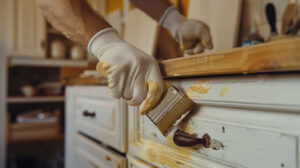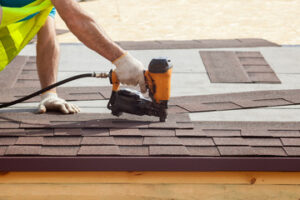Cabinet Refinishing Modesto Anchor is a cost-efficient and time-efficient way to dramatically change your kitchen’s look. It is also an eco-friendly alternative to demolition and new construction.

Traditional and DIY wood refinishing requires cabinets to be removed, sanded, and then repainted. However, this approach can be as expensive as a complete replacement or refacing job.
Cabinet refinishing is an affordable option to refresh your kitchen and make it look new again. However, the project requires careful preparation and planning. The best way to avoid costly mistakes is to hire a professional refinisher who can work with your budget and style preferences. Before hiring someone, ask for referrals and read reviews from previous clients. You can also find out how long they have been in business and what kind of experience they have with different finishes.
Cabinet Refinishing costs vary depending on the finish type. Cabinets can be painted, stained, glazed, or shellacked. Refinishing involves stripping and sanding cabinets to the bare wood before applying a new coat of paint or stain. Stripping is often done with a chemical stripper, which requires proper ventilation and safety equipment. This step is usually time-consuming and labor-intensive.
In addition to sanding and stripping, homeowners should be prepared to spend money on supplies and tools. Cabinet refinishing can require a large amount of time, so it is important to plan accordingly. Choosing the right products and tools is crucial to ensure a smooth and even result. For example, it is important to use a quality sanding block and sandpaper for a smoother surface. It is also helpful to wear protective gear during the sanding and stripping process, as well as rubber gloves and a respirator mask.
It is also a good idea to set up a workspace outside of the kitchen or basement for the duration of the project. Creating a workspace will prevent debris from spilling onto other areas of your home and will make it easier to clean up when the job is finished. It is also a good idea to set aside a dedicated space for painting or staining so that it does not get covered up by other items in the room.
Another important factor that impacts the cost of Cabinet Refinishing is the condition of the cabinets. If your cabinets have cracks or chipping, it is important to fill them in before beginning the refinishing process. For minor cracks, you can use a putty knife to apply wood filler and let it dry according to the instructions on the package. It is also a good idea to repair any deep scuffs, nicks, or gouges. If these are not repaired, they will be visible after the new finish is applied and may mar the overall look of your cabinet refinishing project.
Time
Cabinet refinishing is a time-consuming task. However, it can also be rewarding when done properly. Refinishing can give your cabinets a fresh, new look and make them more functional. The process is less expensive than refacing and can be completed in a shorter amount of time. This makes it a good option for homeowners who want to update their kitchen without spending a fortune.
There are many factors that can affect how long it takes to finish your cabinets, including the size of the project and how well you prepare for the work. To ensure a smooth finish, it’s important to sand the surfaces of your cabinets thoroughly. Start with a coarse grit to remove any existing paint or stain, then move on to a finer grit to make sure the surface is smooth. Once you’re finished sanding, be sure to wipe down the surfaces with a damp cloth to remove any dust and debris.
Another important factor is the type of finish you’re using. For example, if you’re painting your cabinets, it may take longer to apply the first coat than if you’re staining them. You should also allow adequate drying time for the final coat. If you’re unsure how long to allow, consult the manufacturer’s instructions for an estimated drying time.
If you’re refinishing your cabinets for the first time, it’s best to test the process in an inconspicuous area before starting the full project. This will help you decide whether the method you’re using is right for your cabinets and prevent any mistakes that could be costly.
It’s also a good idea to wear protective gear and use proper ventilation when working with paint or stain. These products can produce dangerous vapors that can irritate the eyes, nose, and throat. It’s also a good idea to purchase a high-quality sealant to protect your newly refinished cabinets from moisture, dirt, and wear. The sealant will help prolong the life of your cabinet refinishing project. For best results, refinishing should be completed by a professional. They will have the tools and experience necessary to do a thorough job.
Materials
Refinishing your cabinets is a great way to update them without spending a fortune. This process removes the existing cabinet doors and hardware, sands down the wood surface, then applies a new coat of stain or paint. It’s important to properly prepare your cabinets for refinishing, and to have the right supplies on hand. This includes using drop cloths or plastic sheeting to protect walls and floors from paint splatter. You should also use tape to mask areas that you don’t want to paint or stain. You should also wear proper personal protective gear, as stains and paints contain volatile organic compounds that can be hazardous to your health.
Before refinishing your cabinets, make sure they are clean and free of grease, dirt, and grime. This step is crucial to ensuring that the paint or stain will stick and not chip or peel. Using a good quality brush is also essential, as cheap brushes may have limp bristles that will cause streaking in the finished product.
When sanding your cabinets, start with a coarse grit to remove any existing finish and smooth out the surface. After sanding, wipe down the surface with a damp cloth to remove any dust and debris. Lastly, apply a primer to the entire cabinet before painting. Allow the primer to dry for at least an hour before applying a finish coat of paint.
One of the main benefits of refinishing is that it is less expensive and environmentally friendly than replacing your cabinets. Additionally, it allows you to keep your current cabinet structure and layout while updating the look. However, refinishing is not suitable for all cabinets, and it can be difficult to achieve an even application. Additionally, refinished surfaces can chip and peel over time due to regular use and cleaning.
Despite these drawbacks, refinishing is an excellent option for most homeowners. It is relatively easy to do and can make a huge difference in the appearance of your kitchen. Moreover, it’s a great choice for those who are on a tight budget or do not want to spend the money on a full replacement.
Preparation
Before you begin the cabinet refinishing process, it is important to prepare the cabinets. This step ensures that the paint adheres correctly and minimizes imperfections. It also helps ensure that the finish lasts long. If the preparation isn’t done properly, you may experience problems such as peeling or uneven surfaces. In addition, it is essential to use a high-quality primer that offers stain-blocking properties and is easy to apply. It is also crucial to cover your countertops and floors with brown builder’s paper or plastic tarps to prevent any paint splatters from causing damage to these areas.
First, you should clean the surface of your cabinets with a degreaser to remove grease and grime. You can use a sponge or scrub brush to do this. You should also remove all hinges, handles, and hardware from the cabinets. This will make reassembling the cabinets much easier. Make sure you label these items with a permanent marker or Ziploc bags to keep them organized for when you are ready to reinstall them.
Once your cabinets have been cleaned, you should sand them to give them “tooth” and prepare them for painting. Start with a coarse-grit sandpaper and then move on to finer grits. When you are finished sanding, use a shop vac and tack cloth to remove dust particles from the surface of the cabinets.
When you’re finished sanding, the next step is to prime the cabinets. A good quality primer will provide a strong base for the topcoat and help you achieve a smooth, even finish. It should also be water-resistant and stain-blocking to protect your cabinets from spills and moisture.
After priming, it’s time for the final coats of paint. It’s a good idea to do two coats and wait 4 hours in between each. It’s important to use a foam roller instead of a brush to avoid leaving brush marks and smudges.
Finally, it’s a good idea to use a clear polyurethane topcoat for durability. This type of product will help the cabinets resist stains and scratches, and it’s easy to clean with a damp cloth.

